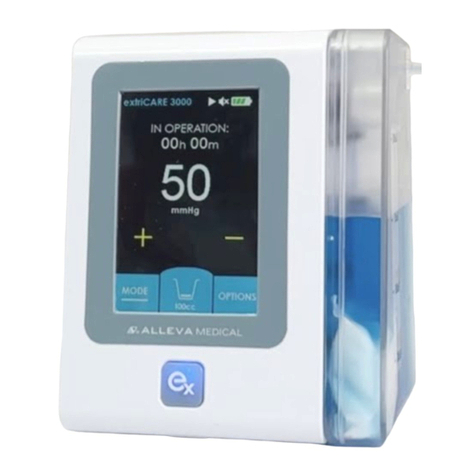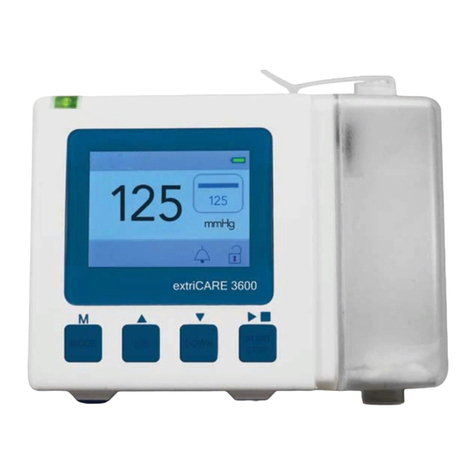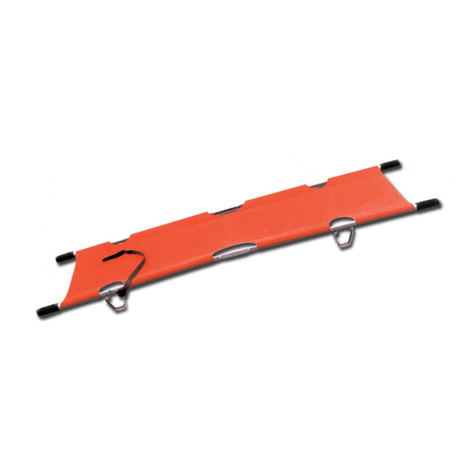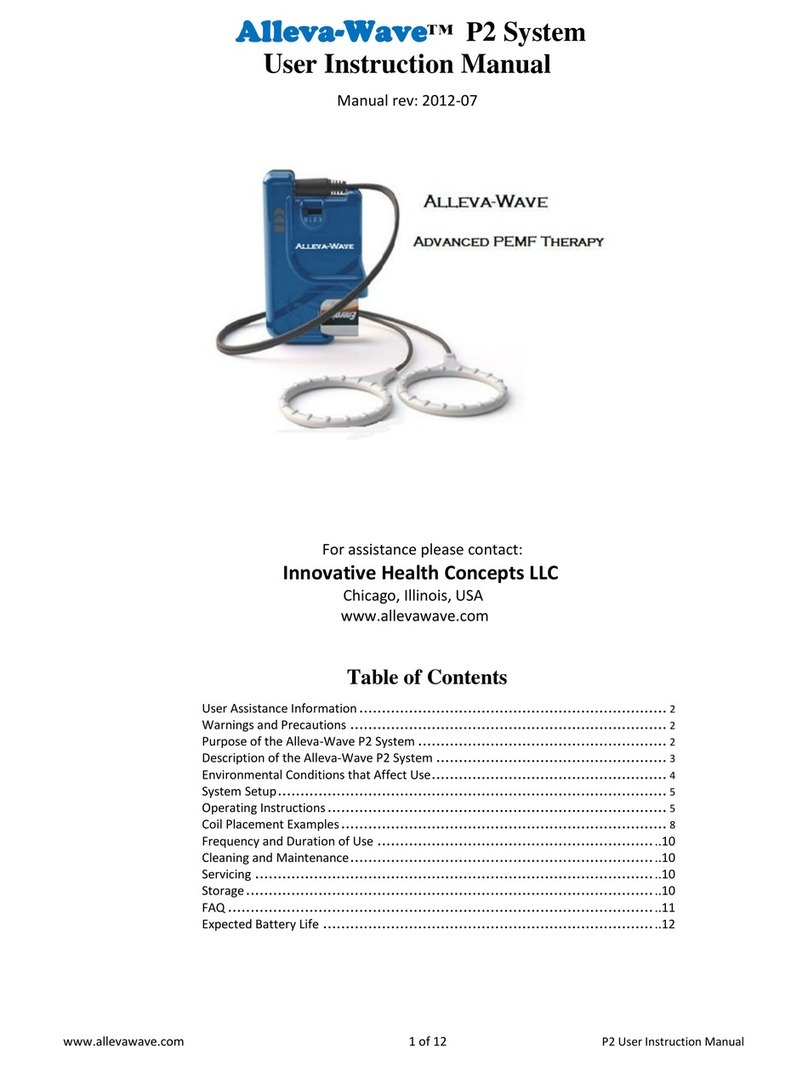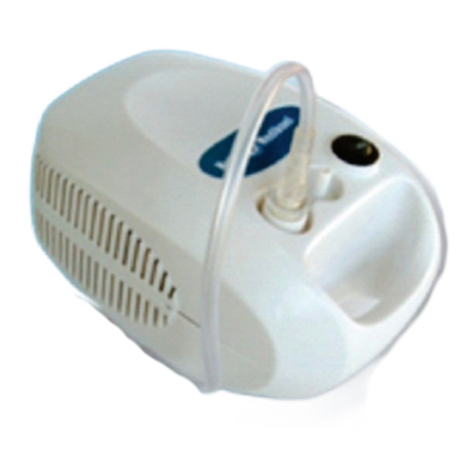Alleva extriCARE 3600 User manual

www.allevamedical.com IFU-MI390-001.004
ENGLISH VERSION - US
Negative Pressure Wound
Therapy System
extriCARE
®
3600
Operating Manual

1. Introduction
Alleva Medical’s extriCARE®Negative Pressure Wound Therapy (NPWT) products consist
of a family of negative pressure pumps and dressings intended to promote wound
healing on patients in either hospital and community settings. Patients with
chronic, acute, traumatic, subacute and dehisced wounds, partial-thickness burns,
diabetic ulcers, neuropathic ulcers, pressure ulcers, flaps and grafts, and closed
surgical incisions may benefit from using the extriCARE®NPWT system.
The extriCARE®3600 NPWT is a portable, battery-powered pump capable of delivering
bespoke continuous and/or intermittent negative pressure intended to promote
wound healing through the drainage and removal of wound exudates, infectious
material, and tissue debris from the wound bed. Each extriCARE®3600 NPWT pump
comes with a sturdy 400cc collection canister provided with solidifying agents to
ease disposal and handling. For wounds with larger drainage needs, a 1000cc
collection canister is also available.
Alleva Medical provides three main type of wound filler dressings to be used in
conjunction to the extriCARE®pump units – the extriCARE®Negative Pressure Wound
Therapy Anatomical Bandages, the extriCARE®ECIM-Series Silicone Dressings, and the
extriCARE®Negative Pressure Wound Therapy Open-Cell Foam Kits. All types of wound
dressing are designed to provide an air-tight environment to the wound bed while
allowing absorption and drainage of wound fluids into the collection canister.
The extriCARE®3600 Negative Pressure Wound Therapy pump allows a user to program
the specific pressure ranging from 40mmHg to 200mmHg. In continuous mode,
the pressure is applied to the wound as long as the pump is powered on.
In intermittent mode, the pump will alternate between applying pressure for
5 continuous minutes and reducing pressure to 20mmHg for 2 minutes.
TheextriCARE®pump is meant for continuous use (at least 22of 24 hours per day).
The extriCARE®3600 pump unit is to be used in hospital or community settings but
not for home use. For home use, the extriCARE®2400 pump is recommended.
Caution: Federal law restricts this device to sale by or on the order of a licensed healthcare
practitioner.
1

2. Package Content
Each box contains:
1. An extriCARE® Negative Pressure Wound Therapy pump unit
2. An extriCARE® 400cc collection canister with solidifying agents
3. A roller stand clamp
4. A 15V/4A AC/DC Adapter with US Plug
12 3 4
2

3. Defined Features
1. Indicator Light: Indicates if the pump is running and functioning properly or an
error is detected.
2. Power Switch (Located on the back panel of the device): Used to turn the system
power on and off.
3. Mode Button: Allows user to set the pump to either continuous or intermittent
mode.
4. Up Button: This increases the set pressure in increments of 5 mmHg up to a
maximum of 200 mmHg.
5. Down Button: This decreases the set pressure in increments of 5 mmHg down
to a minimum of 40 mmHg.
6. Start/Stop Button: Used to start or stop a therapy.
7. Canister: Used to store exudates removed from the wound.
8. Canister Clip: Clip that connects and secures the canister to the extriCARE®3600
pump unit.
9. Tubing Input: This is the connection port used for attaching the extriCARE®3600
dressings to attach to the collection canister.
6. Start/Stop Button3. Mode Button
5. Down Button4. Up Button
9. Tubing Input
8. Canister Clip
7. Canister
2. Power Switch
(Located on the back
panel of the device)
1. IndicatorLight
3

10. Battery Power: Indicates how much battery power is left. Icon has 1-4 bars
representing 10%, 33%, 66%, and 100% battery power, respectively.
11. Mode Symbol: Indicates the current operating mode (continuous or intermittent).
12. Actual Pressure: This displays the real-time pressure reading.
13. Set Pressure: This displays the pressure that the extriCARE®3600 is set for.
14. Canister Error Symbol: Indicates a canister installation error or canister full error.
15. Pump Symbol: Indicates whether the pump is engaged or not.
16. Audio Symbol: Indicates whether the sound is on or off.
17. Lock Symbol: Indicates if the device is locked or not.
18. Charging Symbol: Indicates whether the extriCARE® 3600 is charging or not.
100mmHg
100mmHg
12. Actual Pressure
14. Canister
Error Symbol
13. Set Pressure
18. Charging Symbol
15. Pump Symbol 16. Audio Symbol
17. Lock Symbol
11. Mode Symbol
10. Battery Power
The device can be operated under battery charging condition.
3. Defined Features (continued)
4

4. Symbol List
Mode: Continuous mode: The solid line indicates Continuous
mode. In Continuous mode, the device will always maintain the
set pressure.
Intermittent mode: The dashed line indicates Intermittent mode.
In Intermittent mode, the device will run for 5 minutes at the set
pressure, and then increase pressure to negative 20 mmHg for
2 minutes. The device will continuously repeat this cycle while
in Intermittent mode.
To change between the modes, press the SET button.
Power Adapter: When the device is plugged in and turned on,
the screen will display the power adapter icon. During this time,
the device will be powered by the external power, and the
battery will also recharge.
Bell: When an alarm is occurring, the symbol on the right will
appear, showing that the alarm is not muted. If the alarm is
muted, the symbol on the left will appear. The alarm will
automatically un-mute once the alarm is remedied.
Current Set Pressure: This shows the pressure that the device is
set at. Note that during Intermittent mode, you cannot change
the 2 minutes of negative 20 mmHg.
Error Modes: See section 11.
Lock/Unlock: See section 12.2, step 5
Battery: Full <33%: <10%:
Pump Running: This icon indicates that the pump is turned on
and engaged.
Actual Negative Pressure: This shows the real-time actual pressure.
Alarm: This icon indicates that there is an alarm. Please see the
alarm section 11 for a full description of all of the alarms.
125 mmHg
125 mmHg
5

4. Symbol List (continued)
Warning/Caution: See instructions for use for additional guidance
Single Use Only
Date Of Manufacture
Type BF applied part
Keep Dry
Serial Number
Power Switch
Manufacture Lot Number
Authorized Representative in the European Community
Class II Equipment
Use By
2
SN
LOT
6

Conforms to AAMI STD ES.60601-1, HA 60601-1-11
Certified to CSA STD C22.2 No.60601-1, 60601-1-11
Manufacturer
Catalog / Model Number
Sterilized Using Ethylene Oxide
Refer to instruction Manual
Protected against solid foreign objects of 12.5mm andgreater
and vertically falling water drops.
Waste Electrical Goods Recycled
IP21
7

5. Device Specifications
Temperature: -25°C to 70°C;
Humidity: < 93% non-condensing
STORAGE/TRANSPORTATION
CONDITIONS:
IP21
INGRESS PROTECTION:
<2000m
ALTITUDE RANGE:
800hPa-1060hPa
BAROMETRIC PRESSURE:
5 hours
Continuous or Intermittent
CHARGING TIME:
2.87 lbs (1.3 kg)
WEIGHT:
Model Number: GTM91099-6 015-T 2
AC Input: 100-240Vac, 50/60Hz, 1A, 49W Max
DC output: 15V 4A, 40W
VACUUM MODES:
AC/DC ADAPTER:
Length: 6.7” (17cm)
Depth: 4.3” (11cm)
Height: 5.1” (13cm)
DIMENSIONS:
40mmHg - 200mmHg
in increments of 5mmHg
PRESSURE OPTIONS:
Temperature: +5°C to 40°C (41°F to 104°F)
Humidity: 15-93%
OPERATING CONDITIONS:
Lithium Battery, 11.1V, 5200mAh
(rechargeable)
BATTERY TYPE:
Type BFPATIENT PROTECTION:
Class II
PROTECTION AGAINST
ELECTRICAL SHOCK:
8

6. Accessories
1. AC/DC Adapter: Please only use the AC/DC adapter provided in the package.
2. Tubing Set: 1.55mtubing with a luer-lock connector on one end preattached.
A clamp is also attached to the tubing.
3. Canister: Available in 400cc and 1000cc.
4. Dressings: Please contact your local distributor for a complete listing of all
current dressing options.
5. Carrying Case: For use to carry the device if desired.
7. Indications for Use
The extriCARE®3600 Negative Pressure Wound Therapy Systemis indicated for wound
management via the application of negative pressure to the wound by the removal
of wound exudate, infectious materials, and tissue debris from the wound bed.
The extriCARE®3600 Negative Pressure Wound Therapy System for the following wound
types: chronic, acute, traumatic, subacute and dehisced wounds, partial-thickness
burns, ulcers (such as diabetic or pressure), flaps and grafts, and closed surgical
incisions.
8. Contraindications for Use
TheextriCARE®3600 System should NOT be used in the following conditions:
• Exposed vessels, organs, or nerves.
• Anastomotic sites.
• Exposed arteries or veins in a wound.
• Fistulas, unexplored or non-enteric.
•Untreated osteomyelitis.
•Malignancy in the wound.
• Excess amount of necrotic tissue with eschar.
•Wounds which are too large or too deep to be accommodated by the dressing.
•Inability to be followed by a medical professional or to keep scheduled
appointments.
•Allergy to urethane dressings and adhesives.
• Use of topical products which must be applied more frequently than the
dressing change schedule allows.
9

9. Warnings
• Review this manual prior to usingthe extriCARE®3600 Negative Pressure Wound
Therapy Pump System. If clarification is needed, contact technical personnel or
Alleva Medical Products at 1-877-312-NPWT prior to use. Additional questions
can be immediately addressed aswell.
• Do not use the extriCARE®3600 Negative Pressure Wound Therapy Pumparound
explosive or flammable material. Do not use the pump in an MRI environment
or hyperbaric chamber. Disconnect prior to defibrillation.
• This device should be used only under the direction of a trained professional,
such as a doctor ornurse.
• Larger canister sizes (400cc or larger) should only be used in a facility where
drainage can be closely monitored due to the increased risk of injury to the
patient due to bleeding when using the 400cc canister. Precautionary measures
should be taken forpatients who have an increased risk of bleeding (Please see
Section 10.1 #1) when using larger canisters.
• Negative Pressure Wound Therapy has not been clearedfor use on children.
• Use a properly rated charger to charge the lithium battery. Incorrect voltage
and/orcurrent can cause fire.
• Do not place this device at temperatures greater than 170°F for more than 2
hours which may cause a battery fire.
• If batteryswells, gets hot, or smokes while charging, disconnect the charger
immediately. This may cause the battery to leak, and the reaction with air may
cause the chemicals to ignite, resulting in fire.
• Battery may need to be replaced after 500 discharge cycles.
• Avoid heat from a fireplace or radiant heater.
• Use the device in a clean environment; one that is free from dirt, dust, pets,
hair, etc.
• Do not position the device that makes it difficult to unplug the power cord.
* There is a risk of strangulation if one gets tangled in the cables or tubing.
Keep away from babies and children.
10

10. Precautions
10.1) Be aware for any of the following conditions:
There are additional conditions to take into account before using Negative Pressure
Wound Therapy, such as:
1. BLEEDING:There is a risk of bleeding/hemorrhaging with negative pressure
wound therapy. If hemostasis cannot be achieved, if the patient is on
anticoagulants or platelet aggregation factors, or if the patient has friable blood
vessels or infected vascular anastomosis, he or she may have an increased risk
of bleeding; accordingly these patients should be treated in an inpatient care
facility per their treating physician.If active bleeding develops suddenly or in
large amounts during therapy, immediately disconnect the pump, leave the
extriCARE®wound dressings in place, and take measures to stop bleeding.
Seek medical attention immediately.
2. VESSEL ANDBONE PROTECTION: Precautionarymeasures should be taken if any
bones, vessels, ligaments or tendons are exposed. Additionally, sharp edges
(due to bone fragments) require specialattention; these areas should be
covered and smoothed whereverpossible. These conditions should be factored
into the therapyprescription as the attending clinician sees fit.
3. ENVIRONMENT: The extriCARE®system should not be used in an magnetic
resonance im-aging (MRI) environment, in hyperbaric chamber environment
(HBO), nor with defibrillation. Please disconnect device and/or remove
dressings as instructed by your physician if these situations arise.
4. INFECTION:Infected wounds and osteomyelitis pose significant risks for
Negative Pressure Wound Therapy.If untreated osteomyelitis is present, therapy
should not be initiated. Negative Pressure Wound Therapyshould not be used to
treat infections, and all infections should be treated and addressed priorto
using the extriCARE®Negative Pressure Wound Therapy System.
5. PATIENT SIZEANDWEIGHT: Patient sizeand weight should be taken into account
when prescribing therapy. In addition, small adults, young adults or elderly
patients should be closely monitored.
11

10.1) Be aware for any of the following conditions (continued):
NOTE: If any of this information is not understood, contact the manufacturer before using
the device.
6. SPINAL CORD INJURY: If a patient experiences autonomic dysreflexia
(sudden changes in blood pressure or heart rate because of sympathetic
nervous systemstimulation)discontinue extriCARE®therapyto minimize
sensory stimulation and give immediate medical assistance.
7. MODE: In unstable anatomical structures, continuous rather than
intermittent therapy is recommended to help minimize movement and
instability. Continuous therapy is also recommended in patients with an
increased bleeding risk, profusely exudating wounds, fresh grafts and/or
flaps, and wounds with acuteenteric fistulae.
8. ENTERIC FISTULAS:Wounds with enteric fistulas require special consideration
to be effective in negative pressure wound therapy. If enteric fistula effluent
management or containment is the only goal of such therapy, extriCARE®is
not recommended.
9. CIRCUMFERENTIAL DRESSING: Do not use circumferential dressings.
10. BRADYCARDIA: Avoid placement of the extriCARE®3600 Negative Pressure Wound
Therapy Dressingsnext to the vagus nerve to minimize the risk of bradycardia.
11. PERIWOUND SKIN: Protect periwound skin with additional hydrocolloid,
other transparent film, or other skin prep methods. Monitor skin for any signs
ofirritationorirregularity. Ifthis occurs, stop treatment and consult physician.
10.2) Prior to Therapy
• Patient should be assessed and measures should be taken to optimize and
stabilize their medical condition. Nutrition, medication, blood glucose, blood
pressure, and circulation as well as other medical issues should be addressed.
• The wound should be recently debrided by whatever measure is appropriate
and the amount of necrotic tissue should be minimized.
• Issues of infection should be addressed.
12

10.3) Periwound Skin
• Ensure that the skin that will be under the dressing is clean, dry, free of
surfactants and oil. Any hair should be clipped.
• The periwound area should be cleaned and allowed to air dry. The use of
a skin preparation wipe is also recommended.
• A thin film dressing or hydrocolloid may be used as additional protection.
• Monitor skin for signs of irritation or breakdown. Treatment may be
discontinued if this occurs and cannot be managed.
10.4) Dressing Management
In the event that the extriCARE®wounddressings comes apart, all extriCARE®wound
dressings materials must be removed from the wound prior to further treatment.
Clean and debride the wound as necessary. Any bleeding should be controlled.
Follow facility protocol for wound prep and infection control.The type of extriCARE®
wound dressings chosen for use is dependent on the wound type, size, and
location. extriCARE®wounddressings size and type is labeled on each package.
• Care should be taken to avoid stretching of the dressing.
• Avoid pleating the extriCARE®wound dressings. Additional tape and
urethane may be applied to secure the extriCARE®dressing in place.
• Do not use as a circumferential dressing.
• Additional wrap dressing may be applied over the extriCARE®wound
dressings to further secure the extriCARE®wound dressings and provide
additional support.
• If used on anatomically challenging areas or where adhesion is a problem,
a thin layer of ostomy paste may be applied.
• Refer to instructions for specific information regarding each extriCARE®
wound dressings.
• In a non-infected and monitored wound, dressings should be changed no less
frequently than every 72 hours. Disconnect the dressing from the drainage
tubing and gently peel off to remove.
13

Error Type
Canister
Installation
Error
Low
Battery
Error
High
Voltage
Error
Canister
Full Error
Audio Alarm
Features
3 beeps
every 20
seconds
3 beeps
every 20
seconds
3 beeps
every 20
seconds
3 beeps
every 20
seconds
System Status
Pump will
not run
Fuse may
blowout
Pump
remains
funtioning
until the
battery
depletes
completely
Pump will
shot off
immediately
Suggested
Mitigation
Properly
install the
canister
Unplug the
adapter and
use the rec-
ommended
adapter
Plug the
extriCARE®
3600in
allowing it
to function
and charge
simultane-
ously
Install
a new
canister
Cause/Description
The canister is
not detected or is
installed incorrectly
“Check Canister”
The extriCARE®3600
is being used with
an adapter that is not
recommended; There
is a risk of voltage
incompatibility if
the input voltage
is greater than 16V
“High Voltage ”
When the battery
contains less than
10% power. This
indicates that the
system will shutoff
soon
“Low Battery ”
The canister is
equipped with full
sensors that will
be triggered either
when the canister
is full of exudates,
or a false fullness is
caused by incorrect
use of the system
“Canister Full ”
Visual Alarm
Features
Yellow LED
flashing every
2 seconds
Yellow LED
flashing every
2 seconds
Yellow LED
flashing every
2 seconds
11. Alarm Features / Troubleshooting
125mmHg
00mmHg
?
Check Canister
40mmHg
40mmHg
High Voltage
40mmHg
40mmHg
Low Battery
Yellow LED
flashing every
2 seconds
40mmHg
40mmHg
Canister Full
14

Error Type Cause/Description Audio Alarm
Features
Visual Alarm
Features
Suggested
Mitigation
System
Status
Air
Leakage
Error
Severe
Leakage
Minor
Leakage
Pump is unable to
reach 80% of the
preset pressure
after 5 minutes
of pump effort
“Leakage Detected”
There are many potential sources of leaks (incomplete seal between extriCARE®3600
dressing and skin, improper connection between tubing, canister leakage, etc.). The
alarms have been divided into two categories, mild and severe.
1 beeps
every 20
seconds
3 beeps
every 20
seconds
Pump
remains on
Inspect for
possible air
leaks between:
-the wound and
extriCARE®
dressing
-the extriCARE®
dressing and
canister
-the canister
and pump
- if necessary,
power off and
back on to
restart the
system after
adjustment
Pump
remains on
but will
shut down
after 10
minutes of
continuous
alarm and
without any
operation
Yellow LED
flashing every
2 seconds
Pump unable to
reach 50% of the
preset pressure
after 2 minutes
of pump effort
“Severe Leakage”
Yellow light is on
constantly
11. Alarm Features / Troubleshooting (continued)
40mmHg
30mmHg
Leakage Detected
40mmHg
10mmHg
Severe Leakage
Blockage 3 beeps
every 20
seconds
Pump
remians on
Replace with
new dressing
and tubing set
Yellow LED
flashing every
2 seconds
Tubing or
dressing clog
or blockage
“Blockage Leakage”
40mmHg
40mmHg
Blockage
15

12. Instructions for Use
12.1) Dressing and Canister Application
extriCARE®Wound Dressings include bandages and foam kits. Follow detailed
instructions that come with your extriCARE® Wound Dressingto apply the dressing.
The clinician may loosely place extranon occlusive dressing material into areas of undermining
and tunneling. The decision type of non occlusive material used is based on clinician preference.
Document the amount of additional packing material used.
extriCARE®wound dressings should be changed as needed.
•The initial extriCARE®wounddressings should be changed in 24 - 48 hours or
when leaking, whichever comes first. extriCARE®wound dressings should not
be left in place longer than 72 hours.
•If the extriCARE®wound dressings sticks to the wound, moisten with saline or
water during removal. Adhesive remover may be used.
•Dispose of soiled extriCARE®wounddressings according to facility protocol.
Avoid outside sources wetting the extriCARE®wounddressings. The extriCARE®
wound dressings should be protected from moisture during bathing or changed
prior to reconnectingto the pump. Do not use the extriCARE®3600 Negative Pressure
Wound Therapy Pumpwhileshowering or bathing. Always disconnect and remove
pump from areas of moisture (bathing areaor tub). Clamp the tubing when
the pump is disconnected.
To remove a canister, pull upon the canister clip on the top of the device and
pull the canisteraway. To reinstall a canister, line up the notches on the bottom
of the canisterholes on the bottom of the extriCARE®3600 pump unit, and then press
the canisterclip into place. The clip should click into place and the canister
should feel snug.
When using on a venous or other leg ulcer:
•Edema control must continue during wound treatment.
• Consider lower pressures when applied over fragile skin.
When applying the extriCARE®wounddressings over toes:
• A thin layer of petroleum jelly or other oil-based ointment should be applied
to nails.
• Additionally, antifungal medication and a small amount of soft dressing
material may be applied between each toe.
16

12.1) Dressing and Canister Application (continued)
When usedon the foot, aggressive measures should be taken to protect the foot
and divert unnecessary pressure.
If the extriCARE®wound dressings is applied over a new graft or
bioengineered tissue:
• It is recommended that a non-adherent open weave or fenestrated
silicone contact layer be applied atop the wound between the graft and
the NPWT dressing.
• Heavy petrolatum or similar products cannot be used as negative pressure
will not have an impact on the wound surface.
• Additional care should be used during dressing change to prevent
dislodging graft.
12.2) Operating the Device
1. POWER ON/OFF: To power on thedevice, flip the POWER SWITCH located on
the back panel of the device. The screen will display the starting image and
the system will complete a self check. After the self check the device will
display the STANDBY SCREEN.
2. PRESSURE CONTROL: The extriCARE®3600has adefaultpressure of 125 mmHg.
This can be changed bypressing the UP or DOWN buttons. The pressure
will change in increments of 5 mmHg with a range of 40 mmHg to 200 mmHg.
Long pressure the UP or DOWN button, the pressure will change continuously
by every 5mmHg.
Start Screen: Standby Screen:
125mmHg
00mmHg
17

12.2) Operating the Device (continued)
3. MODE: The extriCARE®3600can operate in continuous or intermittent modes.
In continuous mode, the extriCARE®3600willcontinuously operateatthe set
pressure. In intermittent mode, the extriCARE®3600will operate for 5 minutes at
the set pressure, and then for 2 minutes at 20 mmHg, and then repeat the cycle.
To interchange between two modes, ensure the device is in ‘unlock state’.
Then press the ‘M’ Mode button for at least two seconds, until the mode
symbol changes on the display.
4. START/STOP TREATMENT: To starttreatment, press the START/STOP BUTTON
for 2 seconds.
5. LOCK/UNLOCK DEVICE: The extriCARE®3600will lockautomatically if thereisno
button input for 3 minutes. At this time, any button press will illuminate the
display with the current settings, but the buttons will not take any input, and
the backlight to the screen will turn off. If there is no additional button presses,
the backlight will turn off after 6 seconds. To unlock the device, press and hold
the MODE and START/STOP buttons for 2 seconds. To manually lock the
device, press and hold the MODE and START/STOP buttons for 2 seconds.
In the case that an alarm occurs when the device is locked, the backlight to
the screen will turn on and the alarm will display.
Continuous Mode: Intermittent Mode:
125mmHg
00mmHg
125mmHg
00mmHg
Unlocked:Locked:
40mmHg
40mmHg
?
18

12.3) Rail Clamp
Rail clamp(Figure 1) is provided to hang the device in case it is necessary.
To use therail clamp, insert the clampboard firmly into the socket located at the
back of the device. Release the screw on the clamp to make space for the hanging
media. Snap the clamp onto the hanging medium with the socket opening facing
the ground. Tighten the screw, make sure there is a secure clamp (Figure 2).
Note:Do not use the device as a hanger and hang objects on the device, i.e.
clothes.
Figure 1 Figure 2
19
Other manuals for extriCARE 3600
1
Table of contents
Other Alleva Medical Equipment manuals
Popular Medical Equipment manuals by other brands

Cosmed
Cosmed K4B2 user manual
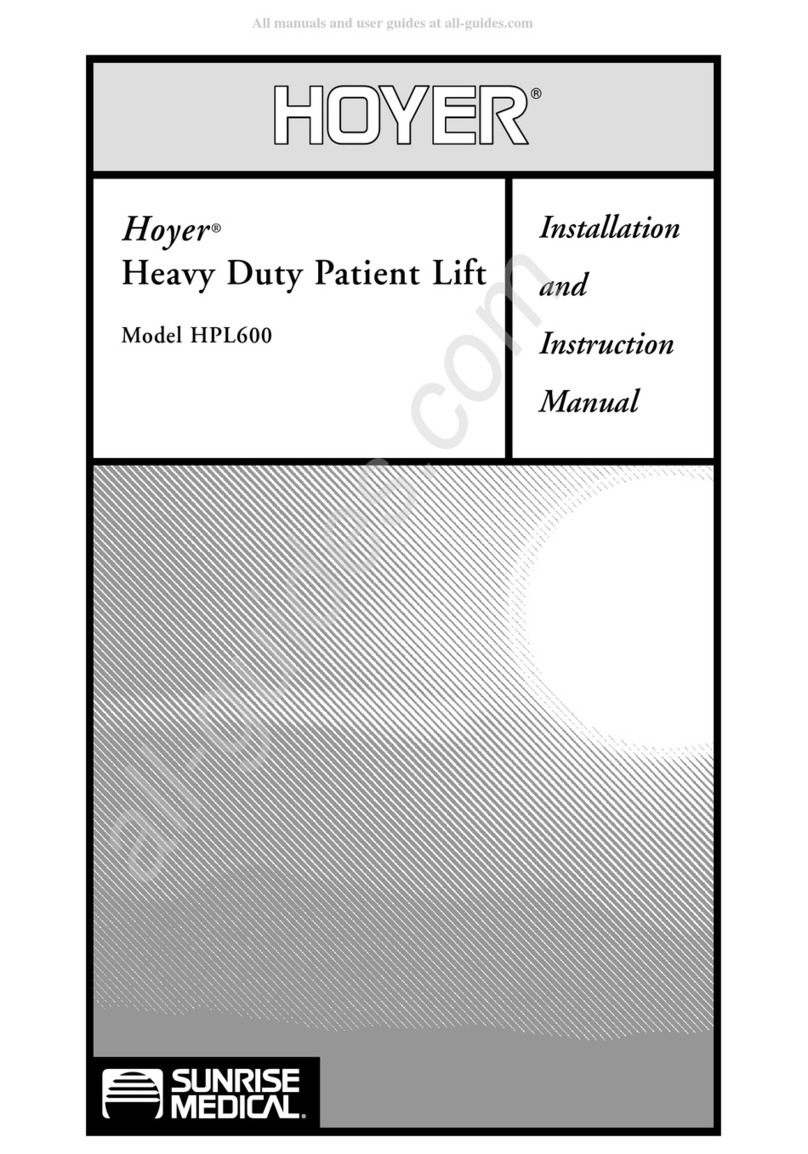
Sunrise Medical
Sunrise Medical Hoyer HPL600 Installation and instruction manual
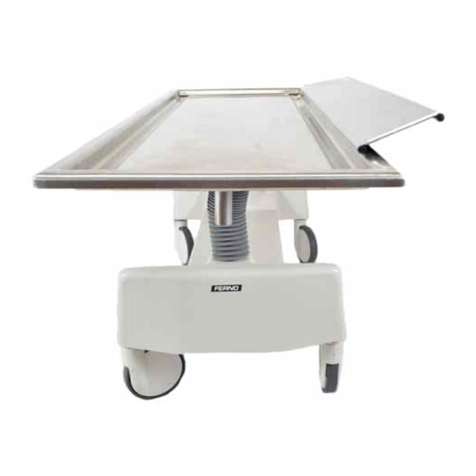
Ferno
Ferno Kit 069-5796 manual
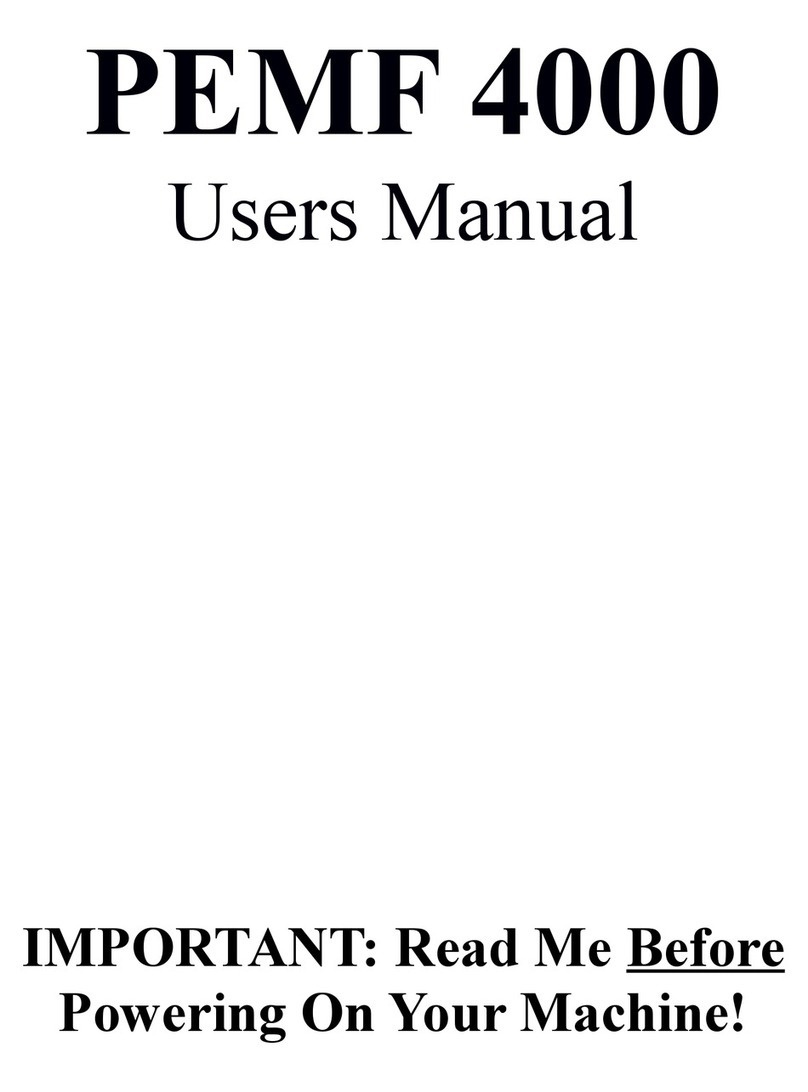
Lemuria Technologies
Lemuria Technologies PEMF 4000 user manual
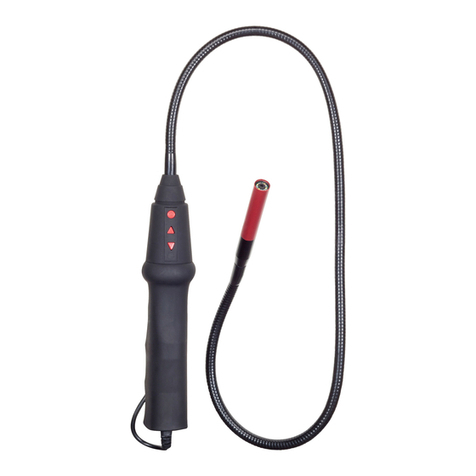
VOLTCRAFT
VOLTCRAFT MICRO-500 operating instructions

Invacare
Invacare Softform Premier Active 2S user manual

Heidelberg Engineering
Heidelberg Engineering SPECTRALIS SPIRIT How-to guide
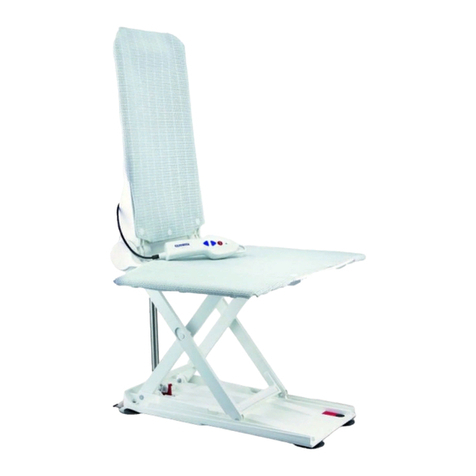
Invacare
Invacare Aquatec R user manual

Otto Bock
Otto Bock 50R300 Dyneva Instructions for use
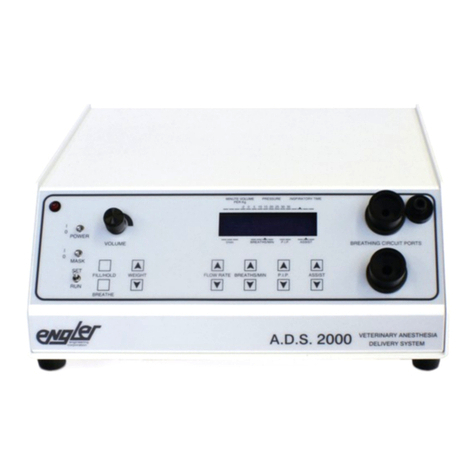
Engler
Engler ADS 2000 manual
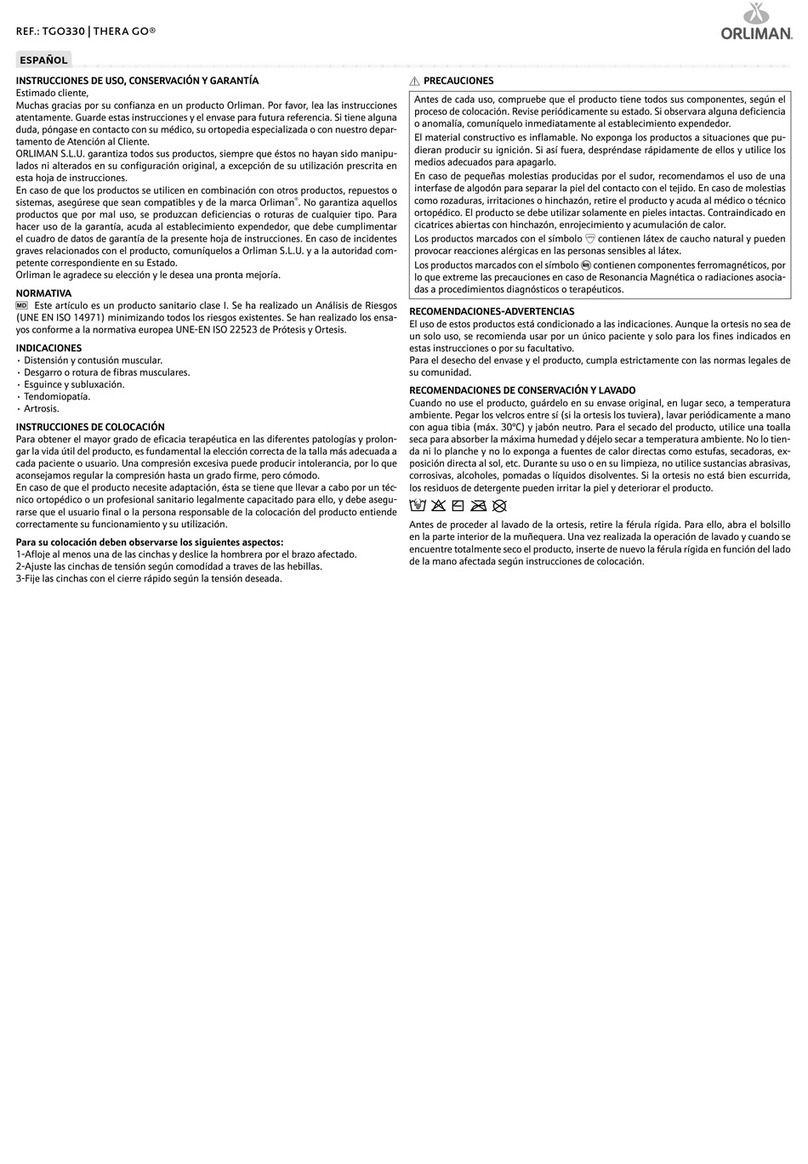
Orliman
Orliman THERA GO TGO330 INSTRUCTIONS FOR USE, STORAGE AND WARRANTY

ISKO KOCH
ISKO KOCH ISKOmed Rotadorm Care Instructions for use
